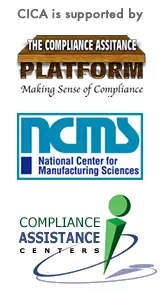
Construction and Demolition Debris Recycling
| Use the C&D State Locator to find state regulations and local assistance. |
A US EPA study found that the construction and demolition (C&D) sector generates more than 500 million tons annually of building-related C&D debris. Most of this material accumulates in landfills, however, experts estimate that 75% of the waste stream is potentially reusable or recyclable. Recycling this waste will help to prolong our supply of natural resources and save money in the process. Common C&D wastes that are recycled include concrete, wood, wallboard, shingles, metal and plastic.
Three recycling methods available to construction/demolition contractors include the following:
-
Mixed material collection - Recyclable materials are transported from the job site, sorted at a designated facility, and sent to processors for recycling.
-
Source separation - Similar materials are separated from other wastes at the job site by category (such as wood, metal, and concrete) and sent to processors for recycling.
-
On-site processing - Recyclable materials are processed on site and made ready for reuse.
Markets for Recycled Material
There are many options and applications of the recyclable material generated by building/demolition sites. These include reuse as building materials, use as an industrial fuel source, mulch in composting operations, animal bedding, and soil amendment. For example, material such as gypsum board (which many landfills are prohibiting from entering) can be ground up and used in many ways such as recycled content for new drywall.
Cost Benefits
There are numerous cost benefits that are resulting from C&D recycling including: reduced project disposal costs, reduced transportation costs, reduced cost of new construction materials, reduced labor costs (less material being handled), and the elimination of the need for new materials for road base, mulch, and landscaping.
C&D Recycling – Specific Materials
The four most recycled C&D wastes are described in this section.
Concrete. Concrete is the greatest component of construction and demolition (C&D) debris by weight. Concrete debris is routinely shipped to C&D landfills for disposal, but recycling is increasing due to improved environmental awareness, changing regulation/laws and economic benefits.
The most common method for recycling dry and hardened concrete involves crushing. Screens are used to achieve desired particle size, and remove dirt, foreign particles and fine material from the coarse aggregate. The resultant material can be used as base course (road base), or the untreated aggregates used for various purposes, including foundation for roadway pavement, aggregate for ready-mix concrete (replacing 10% or more of the virgin aggregates), soil stabilization, and pipe bedding for underground utilities.
Uncrushed concrete is used for landscape materials, underpass abutment structures, erosion structures, and retaining walls.
Due to its bulk and weight, concrete recycling is mostly done on a local basis. Earth911.com can help you find nearby concrete recycling centers.
Wood Waste. Wood is the most significant component of construction and demolition waste by volume. Recycling wood from construction sites mainly involves either salvage (intact lumber, doors, windows, etc.) or processing and using the resulting material. Salvage accounts for a small percentage of recycling, although there is a high-end market for hardwoods recovered from demolished barns and old homes. Rather, most recycled wood waste is processed by sorting, then shredding/grinding for secondary purposes, such as:
- landscape mulches or ground covering,
- animal bedding,
- raw material for plywood, particleboard, chipboard, etc.,
- burned in special furnaces for energy production.
Many communities have recycling centers that accept wood waste. There are also companies that specialize in wood recycling and may offer services like hauling and processing. Earth911.com can help you find nearby wood recycling centers.
Shingles. According to GAF, 13 million tons of shingle waste is generated per year nationwide. Asphalt shingles are particularly common and widely recycled. The process includes grinding the shingles into granular size and then using the material as an additive in hot-mix asphalt for road paving.
Also, at least two companies (GAF and Owens Corning) have developed processes for recycling shingles into new shingle products. The GAF process (RoofCycle™ Process) produces new shingles containing approximately 7% recycled content. Owens Corning is focused on both recycling shingles into new shingles and into asphalt paving.
There are specialized recycling centers that accept asphalt shingles for processing. Also, some waste management facilities or landfills may have programs to recycle shingles. Websites like ShingleRecycling.org and Earth911.com can help you find nearby shingle recycling centers.
Gypsum Drywall. Gypsum waste from new construction activities is typically a clean waste, and primarily consists of off-cuts of drywall, when the boards have been cut to fit the dimensions of the wall or ceiling. The waste is typically less than 15% of the gypsum materials used on the site.
Gypsum waste from demolition and reconstruction arises when already installed drywalls, that may have been installed many years ago, are removed in connection with building demolition or renovation. Different from new gypsum waste described above, this type of waste is more likely to present a certain degree of contamination, which can be in the form of nails, screws, wood, insulation, wall coverings etc. For this waste to be recyclable it is required that the equipment processing the waste can separate such contamination from the gypsum to arrive at a pure recycled gypsum.
Gypsum drywall can be recycled into several beneficial products. The core material, which is essentially gypsum, can be used in new drywall manufacturing, as an additive to concrete, plaster, or stucco, as a soil amendment, or even in compost. The paper facer is typically separated from the gypsum core through mechanical processes like grinding and sieving.
Earth911.com can help you find nearby gypsum drywall recycling centers.
More Resources
Construction and Demolition Debris State Resource Locator. Many states have active programs that encourage C&D waste recycling. Use our tool to locate regulatory information and other compliance assistance, lists of C&D landfills, and pollution prevention resources for your state.
Sustainable Management of Construction and Demolition Materials (US EPA). EPA promotes a Sustainable Materials Management (SMM) approach that identifies certain C&D materials as commodities that can be used in new building projects, thus avoiding the need to mine and process virgin materials.
Construction and Demolition Materials Guidance. The RecyclingWorks in Massachusetts program has worked with state and local officials, salvage and reuse outlets, contractors, construction & demolition (C&D) processors and haulers, architects, and other stakeholders to develop consensus-based guidance on how to increase C&D materials reuse and recycling.
Beneficial Use Portal. This web site is a compact, content-rich resource covering beneficial use of C&D and industrial byproducts.
The State of the Practice of Construction and Demolition Material Recovery (2017). This report summarizes the current state of the practice regarding C&D recovery in the continental the United States, and the economic, community, and material-specific factors that influence the rate of C&D recovery.
Recycling Today. A magazine dedicated to various types of recycling.
National Demolition Association. The National Demolition Association is a non-profit trade organization representing more than 1,000 U.S. and Canadian companies which offer standard demolition services, as well as a full range of demolition-related services and products.
Find a C&D Recycler. Locator maintained by the Construction & Demolition Recycling Association.
Where to Buy or Take Recovered Materials and Products. Information on markets for salvaged or reusable materials. Includes link to Organizations Working to Reduce the Disposal of Construction and Demolition (C&D) Materials.
